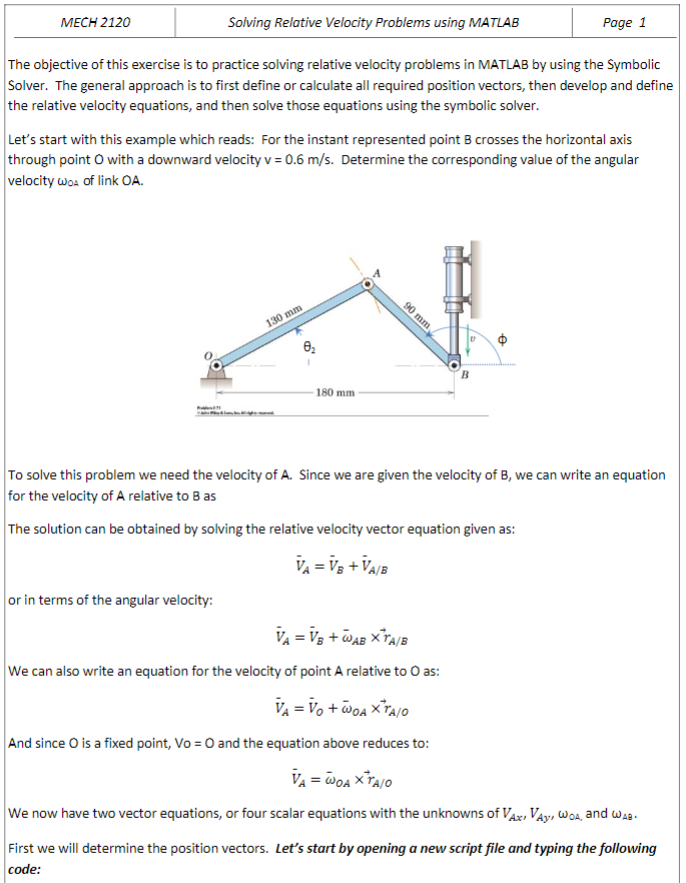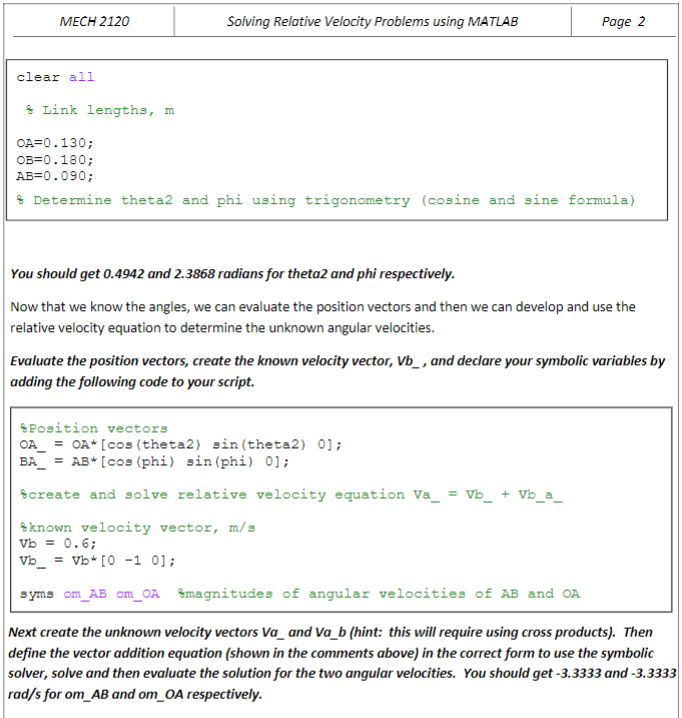Question
My work so far clear, clc; % Link Lengths , m OA = 0.130; OB = 0.180; AB = 0.090; % Determine theta2 and phi


My work so far
clear, clc;
% Link Lengths , m OA = 0.130; OB = 0.180; AB = 0.090;
% Determine theta2 and phi in radians theta2 = acos((OA^2 + OB^2 - AB^2) / (2 * OA * OB)); phi = pi - asin(130 * sin(theta2) / 90);
% Position Vectors OA_ = OA * [cos(theta2) sin(theta2) 0]; BA_ = AB * [cos(phi) sin(phi) 0];
% Create and solve relative velocity equation Va_ = Vb_ + Vb_a_
% Known velocity vector m/s Vb = 0.6; Vb_ = Vb * [0 -1 0];
syms om_AB om_OA
I cannot get the next part of this assignment completed using the solve function in matlab to solve the system of equations and im not sure if its because my equations are wrong or if im using the function incorrectly. Any help would be greatly appreciated.
Problem - Create the unknown velocity vectors Va_ and Va_b. Then define the vector addition equation in the correct form to use the symbolic solver, solve and then evaluate the solution for the two angular velocities om_AB and om_OA.
MECH 2120 Solving Relative Velocity Problems using MATLAB Page 1 The objective of this exercise is to practice solving relative velocity problems in MATLAB by using the Symbolic Solver. The general approach is to first define or calculate all required position vectors, then develop and define the relative velocity equations, and then solve those equations using the symbolic solver. Let's start with this example which reads: For the instant represented point B crosses the horizontal axis through point with a downward velocity v = 0.6 m/s. Determine the corresponding value of the angular velocity won of link OA. 130 mm - 180 mm To solve this problem we need the velocity of A. Since we are given the velocity of B, we can write an equation for the velocity of A relative to B as The solution can be obtained by solving the relative velocity vector equation given as: VA = Vg + VA/B or in terms of the angular velocity: V =VB + AE xA/B We can also write an equation for the velocity of point A relative to O as: V = V + aooa xao And since O is a fixed point, Vo = 0 and the equation above reduces to: VA = doa xojo We now have two vector equations, or four scalar equations with the unknowns of VAX, VAy, Wou, and we First we will determine the position vectors. Let's start by opening a new script file and typing the following code: MECH 2120 Solving Relative Velocity Problems using MATLAB Page 2 clear all * Link lengths, m OA=0.130; OB=0.180; AB=0.090; & Determine theta2 and phi using trigonometry (cosine and sine formula) You should get 0.4942 and 2.3868 radians for theta2 and phi respectively. Now that we know the angles, we can evaluate the position vectors and then we can develop and use the relative velocity equation to determine the unknown angular velocities. Evaluate the position vectors, create the known velocity vector, Vb_, and declare your symbolic variables by adding the following code to your script. Position vectors OA = OA[cos (theta2) sin(theta2) 0); BA = AB* [cos (phi) sin (phi) 0]; &create and solve relative velocity equation Va_ = Vb_ + Vb_a_ & known velocity vector, m/s Vb = 0.6; Vb = Vb* [0 -1 0]; syms om_AB om_OA Emagnitudes of angular velocities of AB and OA Next create the unknown velocity vectors Va_and Va_b (hint: this will require using cross products). Then define the vector addition equation (shown in the comments above) in the correct form to use the symbolic solver, solve and then evaluate the solution for the two angular velocities. You should get -3.3333 and -3.3333 rad/s for om_AB and om_OA respectively. MECH 2120 Solving Relative Velocity Problems using MATLAB Page 1 The objective of this exercise is to practice solving relative velocity problems in MATLAB by using the Symbolic Solver. The general approach is to first define or calculate all required position vectors, then develop and define the relative velocity equations, and then solve those equations using the symbolic solver. Let's start with this example which reads: For the instant represented point B crosses the horizontal axis through point with a downward velocity v = 0.6 m/s. Determine the corresponding value of the angular velocity won of link OA. 130 mm - 180 mm To solve this problem we need the velocity of A. Since we are given the velocity of B, we can write an equation for the velocity of A relative to B as The solution can be obtained by solving the relative velocity vector equation given as: VA = Vg + VA/B or in terms of the angular velocity: V =VB + AE xA/B We can also write an equation for the velocity of point A relative to O as: V = V + aooa xao And since O is a fixed point, Vo = 0 and the equation above reduces to: VA = doa xojo We now have two vector equations, or four scalar equations with the unknowns of VAX, VAy, Wou, and we First we will determine the position vectors. Let's start by opening a new script file and typing the following code: MECH 2120 Solving Relative Velocity Problems using MATLAB Page 2 clear all * Link lengths, m OA=0.130; OB=0.180; AB=0.090; & Determine theta2 and phi using trigonometry (cosine and sine formula) You should get 0.4942 and 2.3868 radians for theta2 and phi respectively. Now that we know the angles, we can evaluate the position vectors and then we can develop and use the relative velocity equation to determine the unknown angular velocities. Evaluate the position vectors, create the known velocity vector, Vb_, and declare your symbolic variables by adding the following code to your script. Position vectors OA = OA[cos (theta2) sin(theta2) 0); BA = AB* [cos (phi) sin (phi) 0]; &create and solve relative velocity equation Va_ = Vb_ + Vb_a_ & known velocity vector, m/s Vb = 0.6; Vb = Vb* [0 -1 0]; syms om_AB om_OA Emagnitudes of angular velocities of AB and OA Next create the unknown velocity vectors Va_and Va_b (hint: this will require using cross products). Then define the vector addition equation (shown in the comments above) in the correct form to use the symbolic solver, solve and then evaluate the solution for the two angular velocities. You should get -3.3333 and -3.3333 rad/s for om_AB and om_OA respectivelyStep by Step Solution
There are 3 Steps involved in it
Step: 1

Get Instant Access to Expert-Tailored Solutions
See step-by-step solutions with expert insights and AI powered tools for academic success
Step: 2

Step: 3

Ace Your Homework with AI
Get the answers you need in no time with our AI-driven, step-by-step assistance
Get Started


